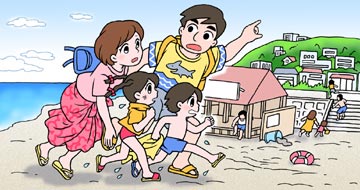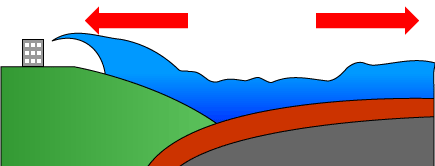Disaster Prevention Resources
Tsunami Preparedness
After an earthquake, there is a possibility that a tsunami may occur.
|
Earthquakes caused by fault movements may cause a tsunami The speed of the tsunami reaching the shore depends on the ocean depth. When far from shore, a tsunami moves as fast as a jet plane, and as it approaches the shore it moves as fast as a bullet train. Evacuating after the discovery of a tsunami may prove to be too late, so if you feel an earthquake, move away from the shore and move to higher ground as soon as possible.
|
 |
When a sea plate moves, the edge of the continent may be caught underneath the edge of another one, causing it to distort.
|
 Accumulation
Accumulation
of distortion
Sea plates
|
|
When the distortion reaches a certain level, it tries to bounce back in order to get back to its original shape, and thereby pushes seawater up.
|
 Bounces back
Tsunami occurs
Bounces back
Tsunami occurs
|
|
The seawater which has been pushed up spreads in all directions. If the sea is deep, the height of the tsunami is low but the speed is fast. If the sea is shallow the height is great but the speed is slow.
|
 The tsunami
The tsunami
spreads
in all directions
|
|
|
|
After an earthquake, there is a possibility that a tsunami may occur.
|
Earthquakes caused by fault movements may cause a tsunami The speed of the tsunami reaching the shore depends on the ocean depth. When far from shore, a tsunami moves as fast as a jet plane, and as it approaches the shore it moves as fast as a bullet train. Evacuating after the discovery of a tsunami may prove to be too late, so if you feel an earthquake, move away from the shore and move to higher ground as soon as possible.
|
 |
When a sea plate moves, the edge of the continent may be caught underneath the edge of another one, causing it to distort.
|
 Accumulation
Accumulation
of distortion
Sea plates
|
When the distortion reaches a certain level, it tries to bounce back in order to get back to its original shape, and thereby pushes seawater up.
|
 Bounces back
Tsunami occurs
Bounces back
Tsunami occurs
|
The seawater which has been pushed up spreads in all directions. If the sea is deep, the height of the tsunami is low but the speed is fast. If the sea is shallow the height is great but the speed is slow.
|
 The tsunami
The tsunami
spreads
in all directions
|
|